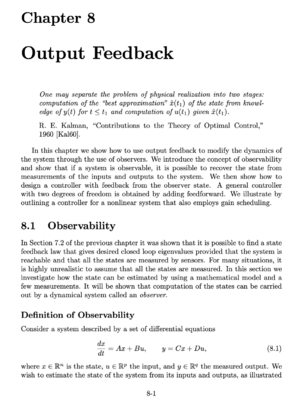Difference between revisions of "Output Feedback"
Jump to navigation
Jump to search
| Line 4: | Line 4: | ||
|Previous chapter=State Feedback | |Previous chapter=State Feedback | ||
|Next chapter=Transfer Functions | |Next chapter=Transfer Functions | ||
| + | |First edition URL= | ||
|Chapter summary=In this chapter we show how to use output feedback to modify the dynamics of the system through the use of observers. We introduce the concept of observability and show that if a system is observable, it is possible to recover the state from measurements of the inputs and outputs to the system. We then show how to design a controller with feedback from the observer state. A general controller with two degrees of freedom is obtained by adding feedforward. We illustrate by outlining a controller for a nonlinear system that also employs gain scheduling. | |Chapter summary=In this chapter we show how to use output feedback to modify the dynamics of the system through the use of observers. We introduce the concept of observability and show that if a system is observable, it is possible to recover the state from measurements of the inputs and outputs to the system. We then show how to design a controller with feedback from the observer state. A general controller with two degrees of freedom is obtained by adding feedforward. We illustrate by outlining a controller for a nonlinear system that also employs gain scheduling. | ||
|Chapter contents=# Frequency Domain Modeling | |Chapter contents=# Frequency Domain Modeling | ||
Revision as of 21:27, 28 August 2021
| Prev: State Feedback | Chapter 8 - Output Feedback | Next: Transfer Functions |
In this chapter we show how to use output feedback to modify the dynamics of the system through the use of observers. We introduce the concept of observability and show that if a system is observable, it is possible to recover the state from measurements of the inputs and outputs to the system. We then show how to design a controller with feedback from the observer state. A general controller with two degrees of freedom is obtained by adding feedforward. We illustrate by outlining a controller for a nonlinear system that also employs gain scheduling.
Contents
- Frequency Domain Modeling
- Determining the Transfer Function
- Transmission of Exponential Signals
- Transfer Functions for Linear Differential Equations
- Time Delays and Partial Differential Equations
- State Space Realizations of Transfer Functions
- Laplace Transforms
- Block Diagrams and Transfer Functions
- Control System Transfer Functions
- Algebraic Loops
- Zero Frequency Gain, Poles, and Zeros
- Zero Frequency Gain
- Poles and Zeros
- Pole/Zero Cancellations
- The Bode Plot
- Sketching and Interpreting Bode Plots
- Poles and Zeros in the Right Half-Plane
- System Insights from the Bode Plot
- Determining Transfer Functions Experimentally
- Further Reading
- Exercises
